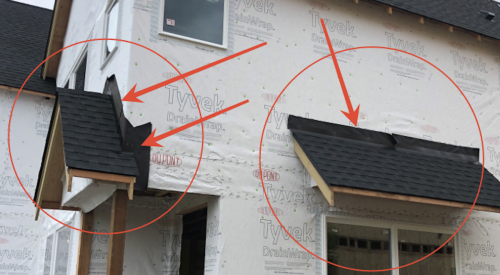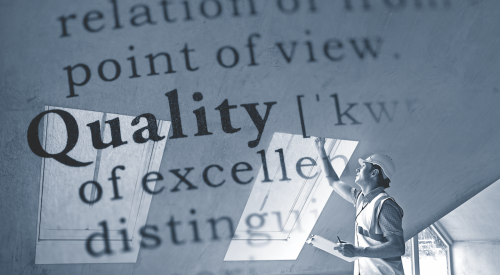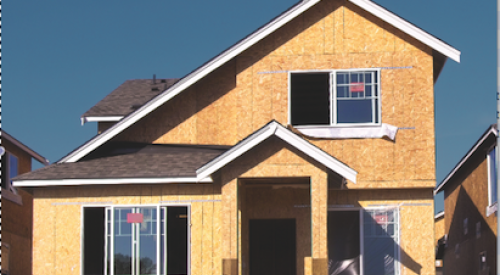|
As energy efficiency obligations force home building to become more complex, home builders are quickly evaluating their construction operations to stay competitive.
Talk these days involves risk management and how builders can deliver a safe, durable and comfortable home in deference to labor talent and building product shortfalls. This task is being relegated to the front lines of construction, requiring the construction manager to adapt to this new burden.
 |
Risk management involves the process of reducing risk or transferring it to others. Quality is about the customer experience and how home builders can deliver a product or service that meets their mutual expectations of safety, durability, comfort and value. Home builders have traditionally favored risk transfer methods, including obligating trade contractors to indemnification agreements and additional-insured endorsements. Now that insurance costs have escalated and some states prohibit express indemnities, it's time to focus on delivering even greater quality. But who will take on this task?
The construction manager is seen as the most likely candidate. If construction managers are to become our front- line quality gatekeepers, home builders need to eliminate much of their paperwork burden, simplify schedule tasks and eliminate time-consuming chores that do not directly add value to the product.
The superintendent fits into other scenarios, too. Today's job sites waste or spoil five to 10 tons of once-useful raw materials. Yet few builders pay attention to their trades' physical waste and rarely consider the labor waste of inefficient job access, lack of power and lighting, dirty work sites and poorly maintained equipment. How we investigate and eliminate this waste depends on the quality processes we put in place and how we encourage our team to spot and challenge waste so it can be converted into profit.
In a factory, workers are employed by the company. The company trains them, supervises them, provides them with tools and maintains their environment. This helps to deliver consistency. Job sites, in contrast, are the epitome of controlled chaotic disconnects. We struggle to communicate a timetable for their work, battle the environment to protect their materials and, once their work is installed, we fight to keep others from damaging it.
Home builders are learning they — not the trade contractors — run the factory. The tradespeople may not be the builder's direct employees, but they are arguably responsible for the work. Newer insurance products such as Wrap or Owner Controlled Insurance Programs (OCIPs) provide a more generic no-fault coverage yet come with much higher builder financial involvement. In light of this, builders are learning they must play a greater role in exactly how homes get built, what products get used, and how workers must install products to meet the growing legal risks.
 Risk audits can tip builders off to high-risk issues while evaluating built-in quality. |
Many builders recognize the direct costs being sucked out of customer service budgets, but few appreciate the real cost of quality failures. A leaky window requires a visit from the builder, the window company (who in turn blames the cladding contractor), the cladding contractor (who blames the window installer, who blames the window manufacturer) and the drywaller and painter. Assuming the window is repaired the first time, it may take 2–3 weeks of homeowner inconvenience and frustration. It is estimated that the cost of a single failure is $3,500, with indirect costs such as lost loyalty, employee morale and negativity being incalculable. Yet window leaks remain the top residential risk for home builders.
According to Quality Built's 2006 survey of 75,342 completed homes, single-family homes averaged $6,124 of corrected defects, while multi-family homes averaged $7,125. This was the average of high-risk defects discovered during brief site observations during construction that were corrected by the builder. It does not include costs for low-risk issues such as paint, fit and finish, and any cosmetic issues. This $11 billion effect on our housing base reveals there is much we can do to eliminate these defects during the process and construction of our homes instead of relying solely on inspectors to catch them.
Although the nation's largest builders and insurers have endorsed third-party inspections to identify defects, quality experts agree that inspection alone cannot be relied upon to improve quality. Absent a robust quality management system with internal audit and external verifications, third-party inspections are likely to be encouraged in the industry because they have proven to significantly reduce risk over other builder methods. Builders who embrace quality assurance, encourage process development, create feedback loops to evaluate failure and take responsibility for design will eventually lessen the need for external inspections and move toward a more efficient auditing process. Next Steps
Builders are becoming comfortable with third-party inspections, forensic plan reviews and insurance audits. Information from these external sources can help augment builders' internal processes and justify their quality initiatives. Quality Built has recently completed its certification and became the first such firm to achieve ISO 9001:2000 registration (ISO is the International Organization for Standards, a world-wide standards setting organization that is recognized in 158 countries). While only four builders out of 230,000 in the U.S. are ISO registered, the number is expected to dramatically rise.
And while right-to-repair legislation is expanding across the country, most agree that building a quality product is the most significant factor in reducing problems later. Some builders continue to push for liability reform, yet Darius Assemi, president of Fresno, Calif.-based Granville Homes, which completed more than 300 homes in 2006, holds little stock in legislation reform because he feels it only slows down the process of getting a homeowner's real problems resolved. He reminds builders to focus instead on doing it right. "I cannot even remember the last time we had to fix a leaky window, so I know our system is working. He smiles, "I can tell you I sleep very well at night."
| Author Information |
| Stan Luhr is the founder and CEO of Quality Built, a national risk management firm serving more than 2,000 building projects in 28 states.
Special Issue: Risk Management:Overzealous Claims Lead to Liability Woes Liability Insurance for Homebuilders How Homebuilders Can Deal with Difficult Customers |
|












